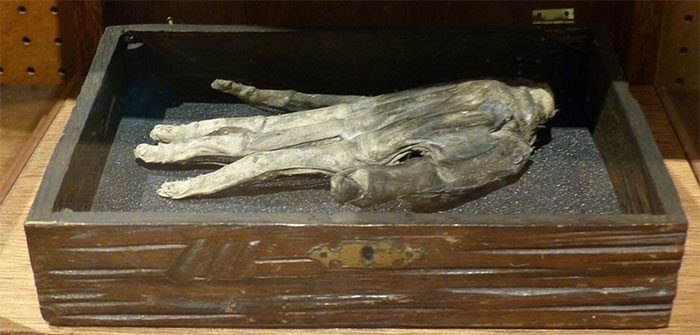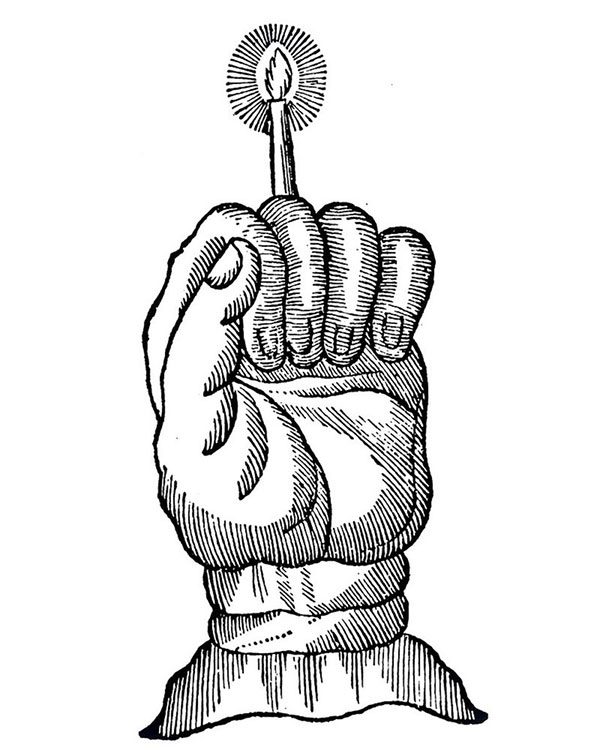Throughout human history, sacred (or mundane) body parts have often been preserved and utilized to bestow power upon their owners. The Hand of Glory is one of the unique and rare relics steeped in eerie legends.
Dark Power
Emerging in the 18th century, the legend of the dried hand of a hanged man has terrified the faint-hearted. Many stories suggest it is the left hand, while others assert it is the right hand of the executed man. If the prisoner committed murder, the relic to be recovered is “the hand that performed the act.”

“The Hand of Glory” on display at the Whitby Museum (UK).
The hand of the dead is considered to possess magical powers in the folklore of many European countries for over 400 years. The name “Hand of Glory” originates from the French term “main de gloire” , abbreviated to “mandragora” (mandrake), also known as mandrake.
Folklore suggests that mandrake is a type of plant that grows beneath the gallows of executed prisoners. Its leaves resemble human hands, and the Saxons believed it would emit light at night. This is one of the peculiar features associated with “The Hand of Glory.”
What kind of person would want to possess the dried hand of a hanged man? Initially, it was thieves who believed in the magic contained within it. According to ancient European folklore, “The Hand of Glory” could unlock any door, allowing thieves to break into homes or shops to loot.
“The Hand of Glory” is not just a fearsome key; its gestures can render anyone who sees it motionless. It also has the ability to put everyone in the house into a state of coma while the thieves go about their work.
Additionally, a candle made from the fat of the dead is sometimes placed on the middle finger after forming the hand into a fist, enhancing its dark powers. It is said that this candle sometimes uses the hair of the hanged man as a wick and can only be extinguished with milk.
How is it made?
The most cited instructions for creating “The Hand of Glory” come from a magic book from 1722 called Petit Albert. Some contents are as follows:
“Take the right or left hand of a criminal from the gallows by the highway, wrap it in a piece of mourning cloth, and pack it tightly. Then, place the hand in a clay pot along with cloves, black pepper, salt, chili, etc., all ground into a fine powder.
Leave it in this pot for about two weeks, then take it out and dry it in full sunlight on hot days until completely dry. If the sunlight is not strong enough, place it in an oven with ferns and horsetail… Next, make a type of candle from the fat of a beheaded criminal, pure wax, sesame, and use ‘The Hand of Glory’ as a base to secure this candle when lit…”.
Petit Albert also provides a useful way for homeowners to avoid the effects of this magic: “The Hand of Glory” will become ineffective and thieves will be unable to use it if you rub the door frame or other parts of the house they could break into with a mixture of black cat’s grease, fat from a white hen, and blood from a barn owl. These substances must be prepared on hot sunny days.
The Whitby Museum in North Yorkshire (UK) has a legitimate “Hand of Glory” in its collection, accompanied by text from a book dating back to 1832, explaining how to create it: “It must be cut from the body of a criminal on the gallows; soaked in salt and the urine of men, women, dogs, and horses; smoked with herbs and dried grasses for a month; hung on an oak tree for three consecutive nights; then placed at a crossroads, and finally hung on the church door for a night…”.

Candle made from human fat attached to “The Hand of Glory”.
How many “Hands of Glory” exist?
No one knows the exact number of such hands. The “Hand of Glory” displayed at the Whitby Museum is said to be the last relic of its kind. However, there are also several hands associated with magic that have been passed down.
A 684-year-old pub in Wiltshire (UK) is also famous for displaying a “Hand of Glory” from a cheating gambler. The cheat was caught playing cards and had his hand chopped off by a butcher and thrown into the fire as punishment.
The hand was not discovered until 1911 when renovations were made to the pub. It was placed in a glass case alongside a deck of cards as a warning to those with dishonest intentions. Unfortunately, this hand was stolen in 2010 and has been missing ever since. This is not the only magical hand to have been stolen.
A “Hand of Glory” embedded in limestone was discovered by a demolition team working at an ancient town in North Rhine-Westphalia (Germany). Locals referred to it as “the false hand” and kept it in a wooden box at St. Brigida Catholic Church from 1907 until it was stolen in 2012.
The unfortunate timing of the theft was significant, as townspeople had raised enough money to send it to the University of Düsseldorf (Germany) for testing to determine the age and gender of the individual to whom the hand belonged. To date, hopes of uncovering the mystery surrounding this magical hand have faded.
The Whitby Museum in North Yorkshire, UK, where a “Hand of Glory” is displayed, has cautiously noted: Please do not attempt to create a magical hand for yourself. Amputating the limbs of a deceased individual (even if it is a man hanged for a crime) is a crime in most countries.


















































